This was published 9 months ago
The town that shed its lingering smell wants to shed its lingering reputation
Bordered by market gardens and a giant sewerage farm, the former farm town of Werribee is experiencing irresistible population growth.
By Adam Carey

Wyndham Harbour, Werribee South.Credit: Joe Armao
Kris Coventry peers down the sheer side of a concrete canal at a powerful stream of murky grey water below.
“That’s what 2½ million people’s worth of sewage looks like,” he says.
We are at the point where approximately half of the outflow from Melbourne’s toilets, taps and showers emerges from underground, at the northern edge of the Western Treatment Plant in Werribee.
The smell reaches me as I lean over the canal to face the flowing effluent. It’s … not that bad. Just a half-waft of sewer smell that is soon carried away on a gusty southerly wind.
Downstream, a flock of swallows flit and feed off tiny morsels on the water’s surface. Above us, a swamp harrier glides slowly in the sky, searching for one of the sewage treatment farm’s resident rabbits.
Melbourne’s sewage has been pumped to this place in Werribee since 1897. The treatment plant is about as big as Phillip Island: so vast it even has a ghost town at its heart, and a coastal marshland that supports almost 300 bird species, an abundance of avian biodiversity second only to Kakadu in this country.
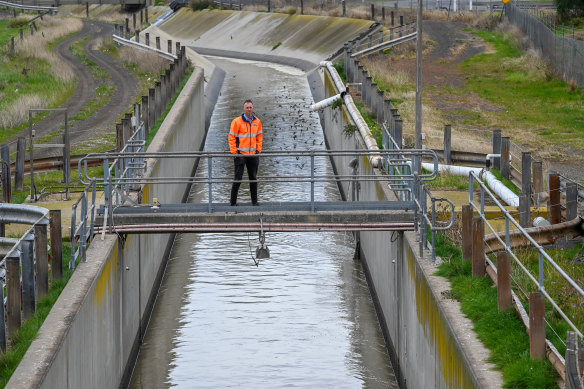
Kris Coventry, acting head of the Western Treatment Plant, stands above the canal where half of Melbourne’s sewage flows. Credit: Joe Armao
For 109 years, the plant used a method called land filtration to treat Melbourne’s sewage: its open paddocks were flooded with a thick layer of raw sewage that dried out and seeped into the soil over several days. Sheep and cattle then grazed on the paddocks, while the effluent flowed through a series of lagoons and eventually drained into Port Phillip Bay.
Merv Hughes, hard-edged Australian fast bowler of the 1980s and ’90s, who grew up in Werribee, says the suburb was “pretty much rubbished by most people in Melbourne for having the poo farm out there”.
Southerly changes brought a faecal pong that doubled as a sign of looming bad weather.
“During the summer, if we got a whiff of the poo farm on a Wednesday, a Shield match would be washed out before we started on Friday,” Hughes says.
Land filtration was phased out for more modern methods in 2006, and Werribee’s infamous smell is much less noticeable.
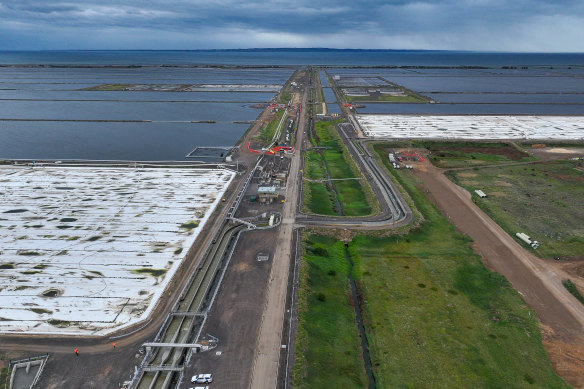
The Western Treatment Plant processes waste naturally, in a series of lagoons, before meeting the bay. Credit: Joe Armao
“I think a lot of the reputation that Werribee has and that the Western Treatment Plant has for being stinky comes from the fact that the land filtration process was quite odorous,” says Coventry, the acting head of the treatment plant.
“It got rid of a lot of pathogens, it got rid of a lot of contaminants, but it certainly didn’t get rid of the smell.”
From farm sheds to townhouses
Just a few hundred metres north of the canal, hundreds of houses are being built in one of Werribee’s newest housing estates.
Werribee and satellite suburbs such as Tarneit, Truganina and Wyndham Vale are in the midst of a seemingly unstoppable population boom. The city of Wyndham has tripled in size in 18 short years, from 112,000 people in 2006 to an estimated 334,000 today. By 2040, it is forecast that 500,000 will call the municipality home.
The volcanic plains west of Melbourne are an accommodating landscape for new housing, but the expansion is applying serious pressure to other land uses the urban sprawl butts up against.
Marco Mason is a market gardener, Werribee South born and bred. His maternal grandfather travelled by ship from Italy to Australia as a boy, and rode a motorbike from South Australia to Werribee on word that there was work there for migrants who could farm the land. Mason’s mother was born there and still lives in the same street she grew up in.
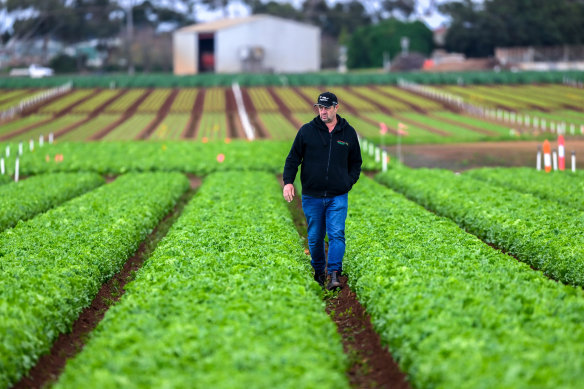
Werribee South farmer Marco Mason says urban encroachment is making farming on Melbourne’s fringe less viable. Credit: Joe Armao
The area’s rich red soil yields reliable supplies of green vegetables that fill Melbourne’s supermarket shelves. This winter, Mason’s fields are full of healthy rows of iceberg lettuce and fennel, awaiting harvest.
“Werribee South is a great farming area; it grows good produce,” Mason says.
The patchwork of farms is in a green wedge zone and protected from urban encroachment by state legislation.
But Mason, who is managing director of one of the largest farming businesses in Werribee South, says the green wedge is no match for Werribee’s soaring urban population, which is creeping into farmers’ turf in troubling ways.
“I don’t see much future,” he says. “As one of the leaders in the industry here, I don’t see it really being viable.”
There are sleek townhouses and luxury yachts moored at Wyndham Harbour, adding carloads of new residents and tourists to a network of farm roads designed for trucks and tractors.
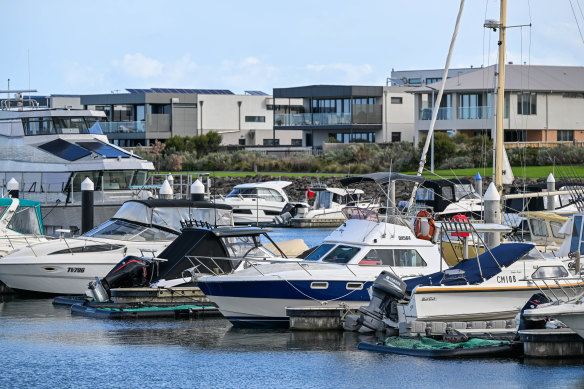
Wyndham Harbour has brought housing and tourism to agricultural Werribee South.Credit: Joe Armao
The Millennium drought forced farmers to turn to recycled water from the treatment plant instead of the Werribee River for crop irrigation, and high salinity has added to soil management costs.
Mason has investigated relocating his farm 50 kilometres westwards, away from Melbourne, and says he would eagerly sell his land to property developers if he could.
“I don’t even want a green wedge. I want it lifted because as an industry we need to evolve. And it’s not allowing us to evolve.”
A river runs through it
The Werribee River divides Wadawurrung land to the west from Bunurong land to the east. When Werribee Riverkeeper John Forrester moved to the suburb in 1981, chasing work as a schoolteacher, the community had barely shed the habit of dumping rubbish into the river.
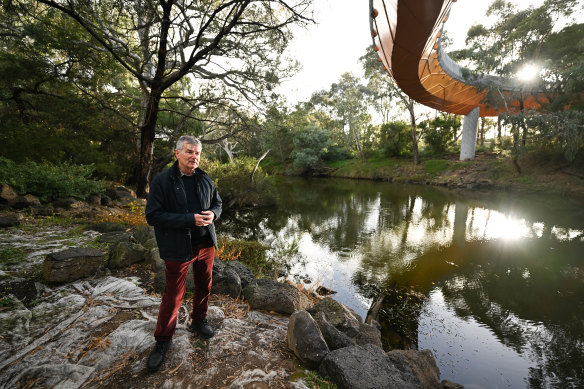
Werribee Riverkeeper John Forrester stands in the town centre, where the river supports platypus.Credit: Joe Armao
“That was what we were doing to our rivers,” Forrester says.
Like many Melbourne waterways, it has since been lovingly restored and is healthy enough now to support a small platypus population, even in the stretch of river that wends through Werribee’s town centre.
“This would be the greatest stand of river red gum riparian forest in Melbourne,” Forrester says proudly.
“That’s why we have a platypus population here because you’ve now got all this vegetation around the place.”
Scientists have estimated that between 30 and 40 platypuses live in the Werribee River. The males are solitary and known to drive other males out of their territory when competing for mates.
“We have a story of a platypus that was found near the Pacific Werribee shopping centre. A young male found in the middle of the street. It looked like it had just come out of drain. It was probably trying to find another waterway,” Forrester says.
Heather Marcus moved into a Victorian-era bungalow with a large and leafy backyard and a view of the river on Watton Street, in Werribee’s centre, in 1970. Today, Watton Street is Werribee’s pulsating, multicultural heart, and Marcus’ home is the last house of its type still standing.
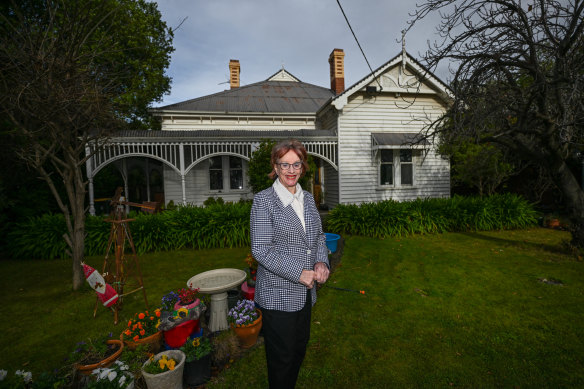
Heather Marcus lives in the last freestanding house on Watton Street, in downtown Werribee. Credit: Joe Armao
Werribee was more country town than suburb when she arrived. Italian farmers would meet in the main street and drink coffee in the afternoon. The sense of remoteness from Melbourne became more acute when the West Gate Bridge collapsed soon after Marcus moved there.
“There was Altona, then there was farmland and the RAAF base that separated the city from Werribee. But now because of the growth, parts of it are very much like the city, with the smaller blocks of land and bigger houses that are boundary to boundary.”
Marcus, 81, a former Wyndham mayor and a current councillor, is no fan of contemporary house design. She laments the loss of gardens and outdoor play spaces for children.
“I’m not in favour of what we are seeing built in our city. But the state government don’t want a sprawling city.”
She has populated her own garden with figurines, including some 700 garden gnomes rescued from being sent to landfill, in the hope of one day creating a “Gnomesville” theme park for local children.
There is no heritage overlay on the property, which is zoned inside Werribee’s central activity centre.
“I’ve been told I can go to six storeys,” Marcus says, though she has no interest in doing so.
“It can’t be built out here.”
Grappling with growth
Marcus was one of just two Wyndham councillors who voted against a new plan late last year to curb unchecked housing development on the urban fringe and build taller and denser housing in established parts of the city, such as central Werribee.
Wyndham’s schools have more students on average than any other part of Melbourne, proof that the region is desperate for more state investment in new schools, the council says.
Wyndham Mayor Jennie Barrera has lived in Werribee since 1990, raising four children there.
The move to Werribee was “a no-brainer”, Barrera says. Housing was affordable, and the drive to the city could be completed in 20 minutes “on a good run”.
These days, a good run is unheard of. Residents consistently list congestion as their worst bugbear.
“You don’t want to jump on the freeway in peak hour,” she says.
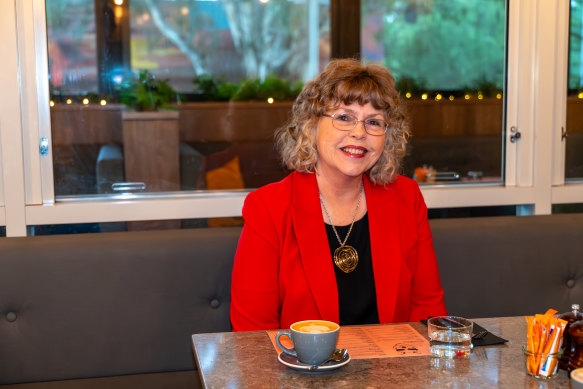
City of Wyndham Mayor Jennie Barrera says the region needs to attract employers, so more residents can work closer to home.
The reason is simple, but difficult to resolve. Housing growth has run far ahead of jobs growth in Wyndham. Just one in three residents works locally.
“I’m lucky, I work here in Werribee,” Barrera says. “Most people have to jump in a car and go elsewhere for employment.”
There are hopes that jobs will sprout like cereals and grains once did at East Werribee’s former state research farm, which occupied 770 hectares of state-owned land.
Once an agricultural testing ground, the enormous site has been a field of failed dreams since the farm was declared surplus to state needs more than a decade ago.
First there was then-Liberal premier Ted Baillieu’s “CBD of the west”, which never happened, followed closely by a fanciful private proposal to build an “education city” with 50-storey skyscrapers, which was canned by the Andrews government in 2019.
After years of silence, last month the Allan government released a new “opportunity statement” for the site, most of which remains empty to this day.
Barrera says the council “has never given up” on the East Werribee Employment Precinct, despite the false starts.
“I know people say that it’s been around for a while now, and it has. It’s been sort of 10 years in the making. Any ambitious plans take time to realise.”
Start the day with a summary of the day’s most important and interesting stories, analysis and insights. Sign up for our Morning Edition newsletter.